
Original Link: https://www.anandtech.com/show/2657
Guitar Hero World Tour: The Best, The Worst, and Everything in Between
by Derek Wilson on October 31, 2008 7:10 AM EST- Posted in
- GPUs
Our recent coverage of Rock Band 2 told a story of love, hate and uncertainty. Today, we cover that uncertainty with a review of Guitar Hero World Tour that fills in the gaps. That's not to say you have to go read the Rock Band 2 article if you haven't: no pop quizes, I promise. The point is that we now have the missing piece for a lot of people: the first music game that adds drums in the franchise that started the craze. Will it live up to the hype, or not? Or will it go a third direction. I'm going to bet on that last one. But that's a little unfair since I'm writing the review ;-)
Anyway, let's get the overview out of the way first. Guitar Hero was the first, and many music gamers cut their teeth on it. Guitar Hero World Tour (GHWT for short), takes it to the next level adding the same compliment of 4 player guitar, bass, drum and vocal action. GHWT is a different game than RB2, though. The approach is different, the implementation is different, and the end result is different in spite of the fact that the underlying concept is the same.
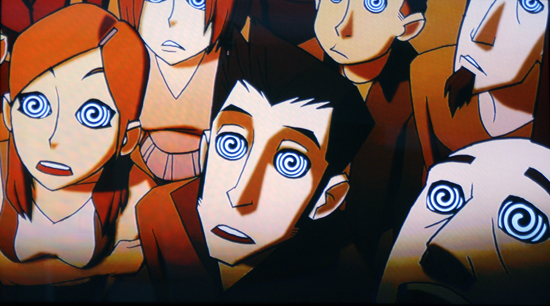
The first notable feature is the cartoonish interface. Rock Band and RB2 are a little more polished and clean looking, but different people will prefer different looks, so this isn't a huge thing. But the functionality of the interface is a bit clunky. We'll cover that more when talking about game modes, but navigating the game is less natural than RB2. Career mode is essentially broken up into 4 different solo careers and one band career, and the line up of songs you encounter is geared more toward the career for that instrument rather than a generalized tour like with RB2. This is good and bad. Actually, you'll probably see that phrase a lot in this article, so prepare yourself.
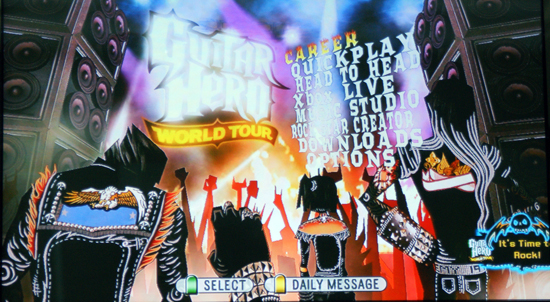
We would expect nothing less from a game called Guitar Hero than innovations in the guitar interface. GHWT also took an aggressive stab at RB2 with a more complex drum controller, but the special sauce is really in their guitar as far as we are concerned. The mic is the mic and it's just about the same as the RB2 mic. There are a couple neat differences in how some things work allowing a little more flexibility, but some of the "innovations" are more frustrating than fun.
The music studio is fairly full featured and allows for a little more creativity than the drum "freestyle" mode in RB2. There is also no way to freestyle with the guitar or bass in RB2, so GHWT adds that as well. But there are some really difficult issues that get in the way of this being a real solid feature.
GHWT online play is better in some ways and worse in others than RB2. Like I said, that'll happen a lot. Let's dispense with this preparatory overview nonsense and really dig in. First up, the guitar (and a sentence or two about the mic).
The Instruments: The Guitar and Mic
So here it is: the thing we like best about GHWT. The new guitar is terrific. Hopefully in the next version of Guitar Hero we'll see them steal the auto calibration idea from Harmonix, but other than that this is a great controller. First let's compare it with the old Guitar Hero controller.
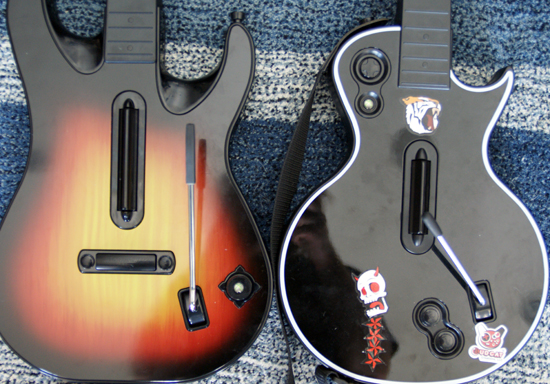
Aside from the neck slide, the changes are subtle. The strumbar is longer, which is awesome. It's solid and clicks when engaged and not sloppy like the RB2 strumbar (also awesome). There is an added star power button right next to the strumbar with two start buttons on either side. This is a great idea, but for the way I play (not sure about everyone else) I would prefer the star power button be a little lower than the strum bar, lets say about the width of my palm away.
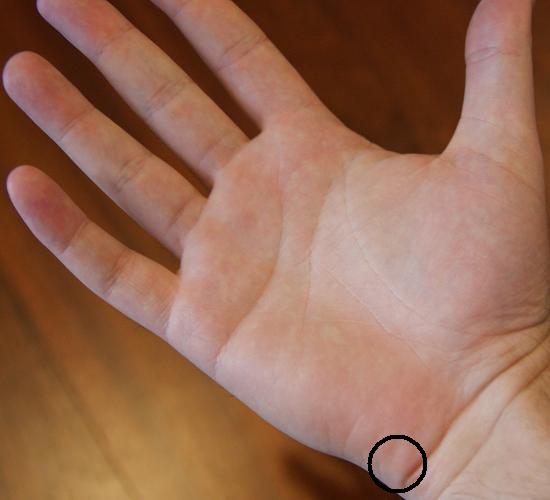
This little bone in the black circle causes my problems ...
Right now it's possible to hit the button, but I've really got to take my hand off the strumbar to do it (which defeats the purpose). When I try and press it, I just hit the start button (along side the star power button) with what I believe is my pisiform bone (or something else that protrudes from the volar surface of the proximal row of the carpus).
This both engages star power (if I'm lucky) and pauses the game. This is not optimal.
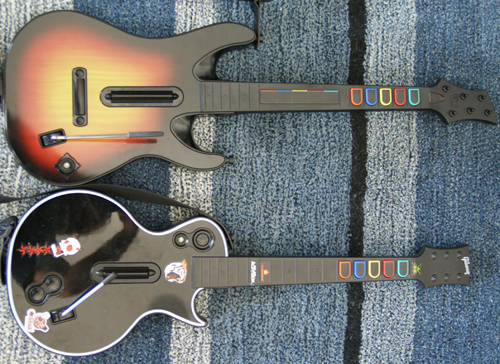
Probably the nicest thing is that the fret buttons are easier to push down. They feel the same, but just lightly tapping them activates them now, which is much nicer on strained hand muscles, especially after hours of playing. We still prefer the button style of the RB2 controller, but the major advantage (the decreased forced required to play) is now nullified.
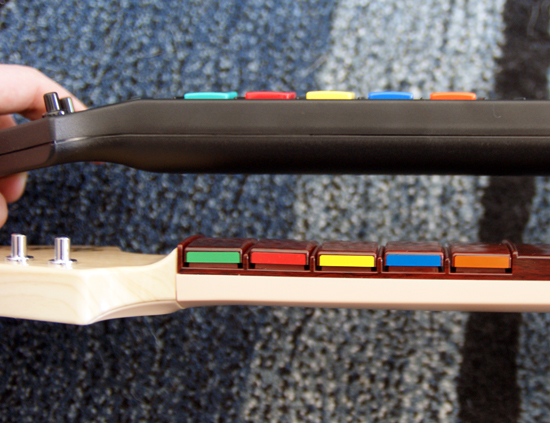
On top of this, the GHWT instruments now feature a connection for the XBox live headset. This is great for online play and is definitely something missing from the RB2 instruments. They also continue to include the RJ11 connector for attaching a pedal to activate star power. Which is a better way to do it than tilt or buttons, but requires the purchase of an add on (or some DIY hacking and an old phone).
So on to the new hardware: the touch sensitive neck slide. This is a pretty interesting feature, but we couldn't get much use out of it. When the "slider gems" pop up it's really difficult to switch between the fret buttons and the neck slide and back again. It's also tough to tap normal notes on the neck slide with the right timing and accuracy. We REALLY want to be able to use this like normal buttons: I want to hold my finger on the green pad and strum a note. Currently this can't be done, which really doesn't make any sense at all. It fells more like a real guitar, would allow easier sliding between notes than any buttons ever, and would really add to the experience.
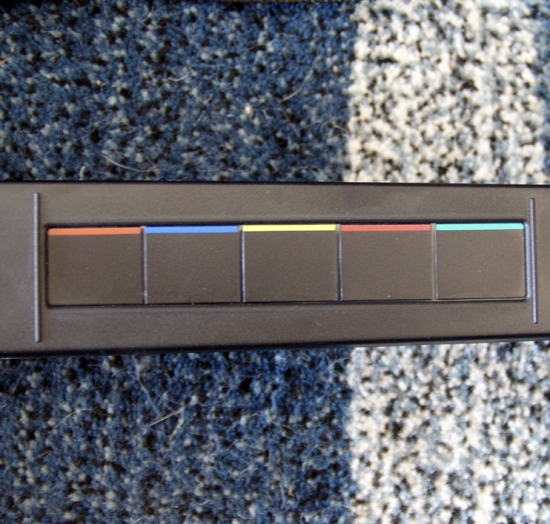
All in all, the neck slide is a cool idea that fell way too short with this first implementation. Hopefully next time around we'll see them get it right, but right now it's just taking up space on the controller.
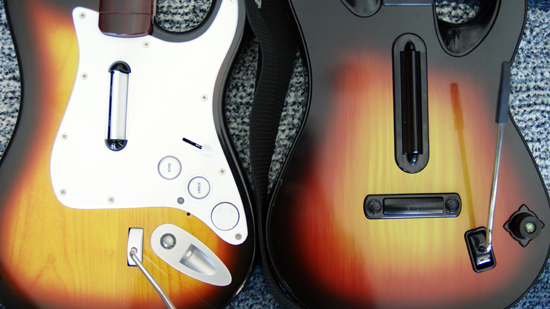
Overall, the Guitar Hero World Tour guitar controller is a good balance and easier for me to play than the RB2 controller. Keep in mind I prefer the RB style controller over the original GH controllers, so the subtle tweaks to the rest of the guitar really made a difference for me. Of course, your mileage may vary. Both controllers are good and it will likely come down to personal preference on which one you go with.
Beyond hardware, GHWT extends the functionality of the game a bit. They've added open notes (represented the same way a kick drum hit would be shown on the drums: a horizontal purple line across the highway). These notes are strummed with no buttons held down. It gets really cool with open note pull offs and makes for some more intricate gameplay. With Rock Band 2 I always found myself holding down the lowest note I needed and just playing the upper ones over top, but with the introduction of open notes you've got to be able to lift all the way off and come back. It's really just another subtle step towards better emulation of real guitar techniques. We're still a long long way off on that, but every step in that direction is a good one.
Another really neat feature is that sustained notes can be sustained /through/ other notes. For example, let's say you play a green sustained note. In some songs, you can hold this down and keep playing other colored notes on top of it. It's actually pretty cool and well done in the songs where we've seen it. This and the other tweaks to the guitar really do make it so that GHWT comes out ahead in terms of a guitar and bass for music games. That's not to say that Rock Band 2 is way off, as you can see if you search youtube for head to head videos. But simply playing the guitar and bass on GHWT is more fun with the extras.
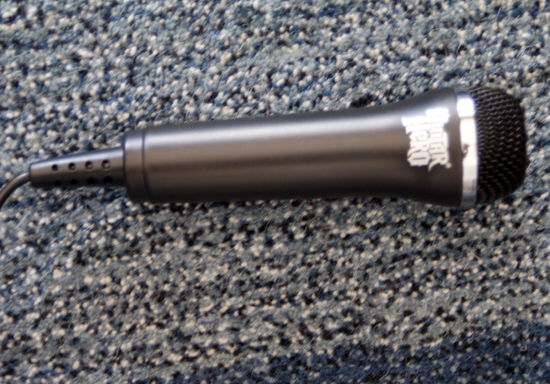
As for the mic, it's the same as the Rock Band mic. You have to tap it to activate star power, but this just does not work. It's way too difficult, and we've tried different types and styles of tapping and it's really hit or miss (pardon the pun). The better way to go is to hit any of the 4 main buttons on the XBox controller. This is even easier if you go with a 3rd party mic that doubles as a controller so you don't have to hold two things to sing.
The only other thing to mention about singing is that it is MUCH pickier about getting it right than Rock Band or Rock Band 2. Singing on hard is VERY hard. And that's not just cause I have a hard time with it. It's cause it's actually difficult. You've really got to nail the transitions between notes and words to get by in this game.
On to the drums.
The Instruments: The Drums
This was where GHWT had the most potential to succeed. The low hanging fruit. Adding an extra trigger and raised cymbals was a terrific step beyond the Rock Band 2 template. It is well documented that Rock Band and Rock Band 2 feature incredibly subpar kick pedals and building a better kick would go a long long way to making a better experience. Unfortunately, Neversoft failed to capitalize where Harmonix fell short.
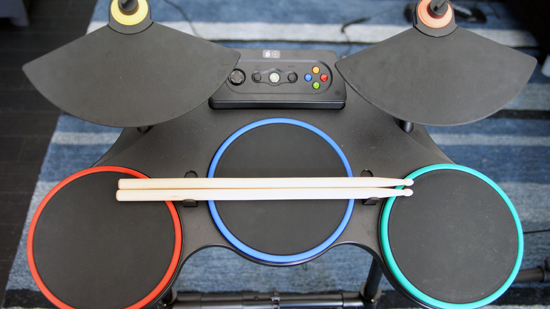
First the good. The GHWT kit has awesome pads. The three "toms" are much bouncier than the Rock Band or RB2 kits, and their sound is deeper and even less of a problem than the quieted down RB2 offering. The angle of the pads is a little less steep, which provides a better experience as well. We love the pads. But that's where it ends.
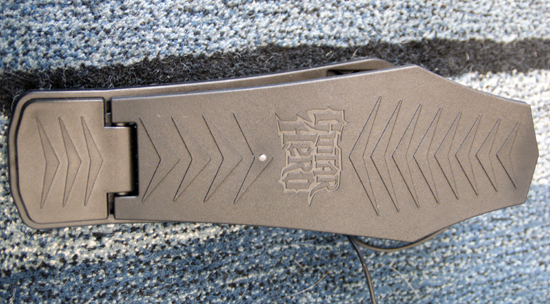
The cymbals aren't very responsive and are essentially dead feeling. This is similar to the ION Drum Rocker's problem, but slightly worse. Not a huge deal, but still. The placement of the cymbals is, on the surface, fine. I tend to have a splash and a crash at about the same general vicinity. But I much prefer my ride and hi-hat on the outside of the kit (far left for hi-hat far right for ride) which is not what we end up with here. The layout of the kit makes playing the blue tom sort of awkward.
And when playing the game, a roll across the toms doesn't look as natural as in Rock Band 2 because of the way the pads are laid out. This isn't a huge deal, and it just takes some getting used to. It is a little worse when using an RB kit, as the yellow pad is never (in our experience) used as a tom. Meaning rolls across the toms will skip from red to blue to green.
Additionally, as the orange (or blue on an RB kit) cymbal is not far right, there are some times where you've got to make awkward shifts of both hands. I swear there are some songs that just make me feel like I have to play like Stewart Copeland in the video for "Can't Stand Loosing You" for no reason. Actually, that sort of makes sense as he was one of the musicians that helped out with input on the kit before it was released. Seriously though, if you're playing some 16th notes on the orange cymbal (blue on the RB kit) with your right hand and have to hit the green tom without skipping a beat on the cymbal you've got to move both hands REAL fast twice (to get your left hand back to the snare and right hand back to the cymbal). Not a huge problem, but that's just not how I'd play it if the cymbal were really out of the way of the toms and I could just hit the green tom with my left hand.
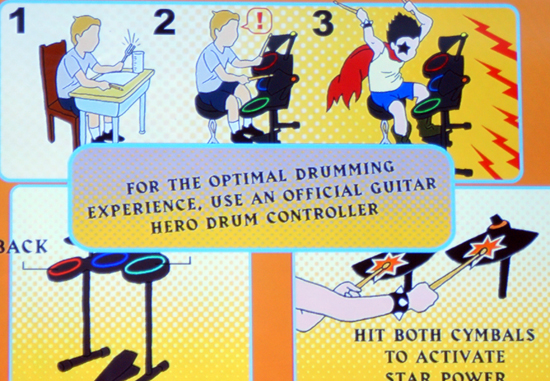
ORLY?! ION/MIDI 4TW.
So yes, we have raised cymbals, but some of the functionality of that is degraded by how close to the toms the cymbals are, and the layout can be a bit confusing. It's worse on the RB kit with GHWT because they seem to have taken the easy way out and just combined the orange and blue lanes into one so that the yellow trigger is always a cymbal and the green tom is never a cymbal. No, they didn't have to, but it would have been really nice if they had adaptively combined the orange lane with either blue or green depending on context (ride or crash as per the RB conventions). Beyond that, it would have been perfect if they could have sometimes shifted the red/blue/green rolls to be either yellow/blue/green or red/yellow/blue rolls.
So... What next. Right, star power. That sucks.
Here's the problem. You've got to play the song, ideally without missing notes. In order to activate star power you need to hit the yellow and orange cymbals at the same time (or yellow and blue on Rock Band). But this is really tough in some songs, especially songs like Dammit and Everlong. Waiting for a break to throw it in is fine in some songs, but in others it's just stupidly hard. We understand the limitations of the RB/RB2 random fills method, but there should really be some other (better) way to activate star power with the drums.
One thing that does work is accent notes. These notes are visually different and you get a bigger score if you hit them harder. It's kind of cool, and it seems to get used often for open hi-hat hits in the songs we saw it used in. It works. It's neat. Unfortunately it doesn't work with the RB2 or ION kits even though they are also pressure sensitive (it just turns this feature off with the 4 lane version).
Drum Hardware Way Ups and Way Downs
Downs first: physical problems. Yes we have them.
First and foremost: the kick pedal sucks. And beyond that it sucks worse than the RB kick pedal. There is no excuse here. Allow me to elaborate.
The pedal is built out of a much more flexible plastic than the RB pedal. This will probably mean less breakage as it has some give to it. On the down side, if you thought the RB pedal was squishy, you haven't seen anything yet. The GHWT pedal is ... I'm having a hard time thinking of polite words to replace sucks. Sorry. It just sucks.
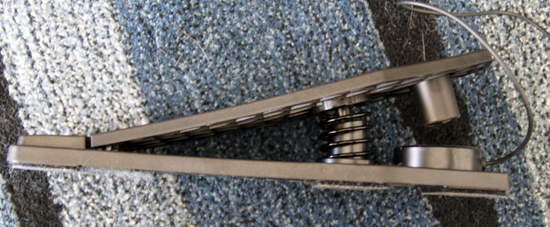
Unlike the RB kick pedal, it doesn't have any sort of anchor or attachment to the rest of the kit, and it doesn't have any of its own anchoring devices. This means it will slide away from you. Horribly. No matter what. Our solution is seriously to turn the kick pedal sideways with the base facing left (for a right footed person) and step on the base with your left foot and hold it there. Then play the top of the pedal with the ball of your right foot. Obviously you play off the pedal, very literally. It works, but it's still not anywhere near ideal. If you want to build something, you can make a more permanent solution like nailing it to a platform that extends under the drum throne.
Here's another problem. Because of the flexibility of the pedal and the fact that it only has one point of contact with the bottom of the pedal (where the sensor is), it wobbles from side to side very easily. This is not something you need to deal with while playing a kick drum. A little off center and it's all over. Fast double hits are MUCH harder with this kick pedal and I would not recommend it for anyone. Ever.
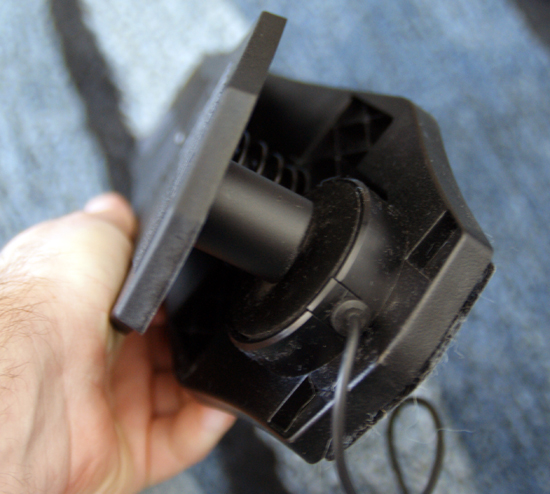
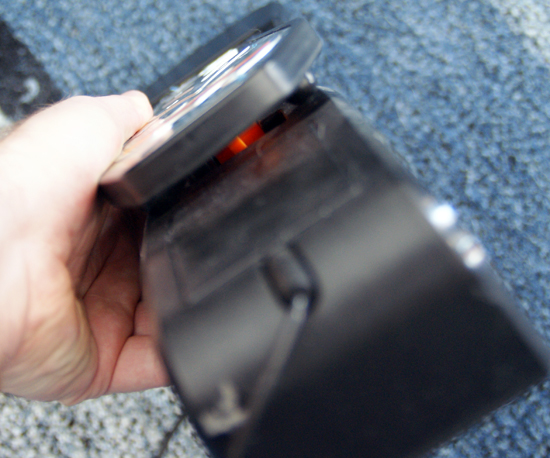
Okay, enough about the pedal.
We've heard about the fact that people are complaining that some GHWT kits have sensitivity issues, that Activision has confirmed this, and that they will be releasing a kit or instructions or something to tune sensitivity. We may have this issue, and it might be tainting our view of the rest of the kit. Our trouble is that when playing the pads, sometimes the cymbals trigger due to vibration. And we don't play hard and never had this issue with any RB kit. At the same time, if we don't play the pads hard enough they don't register. So it's nearly impossible to play songs well even if you don't miss a note with either hits not registering or cymbal hits showing up because of vibration. It's really frustrating.
So we'll deal with that, and I will write a blog post at some later date to elaborate on whether or not adjusting the sensitivity of the pads fixes it. We hope it does, but that still doesn't fix the layout issues and other usability issues we have with the GHWT drum controller implementation.
So all that sounded pretty bad. And it kind of is. There's just no getting around that. But we've got one more really great thing to report on. The saving grace of the GHWT kit if you will.
It's got a midi input. This means you can connect an electronic drum kit to it and play GHWT with it. Now, we haven't tested this yet ourselves, but I should get the chance to use a Roland TD-8 on it soon. Again, future blog post. The other thing we suspect will work that may or may not is using the midi input with Rock Band 2. If this is, in fact, possible, our recommendation will be that anyone with an electronic kit should pick up the GHWT drums to use as a midi-to-XBox converter.
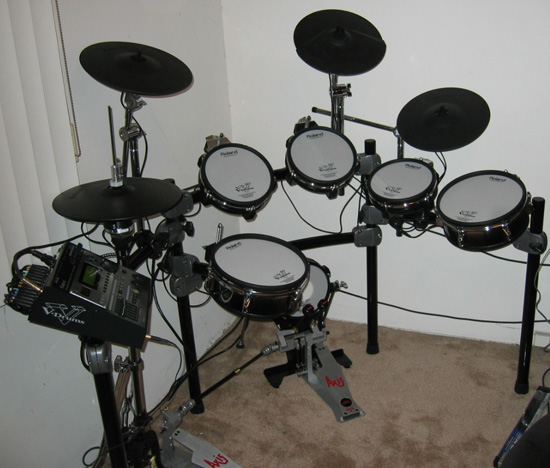
Yes Please? (Roland TD-12, image courtesy wikipedia.org)
This could also mean easy cheating for GHWT though, as you can hook a drum machine or sequencer up to GHWT and very easily program in a song. Again, this is untested by us. But the functionality is there. We'll definitely post something when we get the equipment we need to test it.
In The Studio: Creating Music
This was another place Neversoft had an opportunity to make something really beyond anything else. It's a cool idea and you can definitely build songs with it. But it's tedious and you really need to care about building songs with it to enjoy this aspect of the game. There are a lot of options for types of sounds and it's actually pretty flexible as far as building and editing songs goes. It's no Pro Tools, but it's workable.
For us, there is a bit of a fatal flaw: lag. You know that stuff you calibrate out when setting up the game? Well, it's a little different when you are actually trying to play something. Here's the deal. The lag (in ms) you calibrate out is the time it takes between when the game generates the audio and visual cues for you to hit a note and when it actually receives the input that says you hit that note. That's why you calibrate by pressing a button when you hear something or see something: the game can figure out how much delay is between the song being played and shown and your senses.
In this above explanation, it is implicit that there /is/ delay between the gamer and the game. Thus, when generating music, the same is true. You play something and it takes whatever that delay time is for you to hear it or see it as something having been played. Some setups will be worse, but there will always be some delay. You just can't get around it.
What's the big deal? Well, it makes it tough to play, especially with a metronome. So imagine this. The metronome clicks, then you hear it, then you play, then you hear what you played. Instead of being close enough together so as not to matter, it's all spread apart. For me, when I tried playing a beat with the metronome and heard the beat later my brain wanted to adjust to play so that the beat I heard myself play was on beat with the metronome. Which meant playing before the click. Which I couldn't do because my brain wouldn't let me do because I knew when the click was going to happen and I had to play on the beat. But I couldn't ... so ... you get the idea.
My head essentially exploded into a feedback loop and I had to huddle in a corner and cry for a while till the frustration subsided.
Now, this is worse when using a receiver, but it is still there even when just using and HDMI cable straight into a TV with no effects enabled, though some people may notice it less and not really care. It's still very possible to do things with this feature, but this problem just adds to the tediousness of it. The ability to upload and download created songs is also really cool, and we hope that there are people out there with more patience than we have for making great music with GHWT.
But this feature isn't a reason to buy the game. If you were really excited about the studio, you might have the patience to use it, but it's not up to par this time around. For those who aren't already really into this idea, this isn't the game that will turn you on to creating your own music with a video game.
The Songs
The songs are a really big part of any music game. The cool thing is that there is a decent amount of overlap with Rock Band 2, so you don't need to feel left out of some of the more solid songs no matter which game you pick up. Guitar Hero World Tour has a decidedly more classic influence than RB and RB2, featuring Hendrix, Steely Dan, the Allman Brothers, CCR, Willie Nelson, and other staples. But we also see some completely rockin modern hits from bands like Tool. Especially Tool. Did we mention Tool? There's also some 30 Seconds to Mars, Paramore, and plenty of other modern bands. There's less 90's stuff here, but they've got the important stuff like Foo Fighters, Nirvana, Dinosaur Jr., and Blink 182.
I would have a really hard time choosing, and I'm glad I've got access to both games. Honestly I wish I could merge all the songs onto one platform though. But the music is really important to consider when deciding what game to pick up. So here's the list.
Nirvana - About a Girl (Unplugged)
Enemy The Enemy - Aggro
The Guess Who - American Woman
Trust - Antisocial
Lenny Kravitz - Are You Gonna Go My Way
Muse - Assassin
System of a Down - B.Y.O.B.
Wings - Band on the Run
Michael Jackson - Beat It
311 - Beautiful Disaster
Ozzy Osbourne - Crazy Train
Blink-182 - Dammit
Sting - Demolition Man (Live)
Steely Dan - Do It Again
Radio Futura - Escuela de Calor
Foo Fighters - Everlong
Survivor - Eye of the Tiger
Dinosaur Jr. - Feel the Pain
Modest Mouse - Float On
Korn - Freak on a Leash
Fleetwood Mac - Go Your Own Way
Anouk - Good God
Beatsteaks - Hail to the Freaks
Pat Benatar - Heartbreaker
Filter - Hey Man, Nice Shot
Bob Seger & The Silver Bullet Band - Hollywood Nights
Van Halen - Hot for Teacher
Eagles - Hotel California
Steve Miller Band - The Joker
MC5's Wayne Kramer - Kick Out the Jams
30 Seconds to Mars - The Kill
The Mars Volta - L'Via L'Viaquez
Los Lobos - La Bamba
Silversun Pickups - Lazy Eye
Bon Jovi - Livin' on a Prayer
Doors The Doors - Love Me Two Times
Cult The Cult - Love Removal Machine
The Stone Roses - Love Spreads
Jimmy Eat World - The Middle
Paramore - Misery Business
Tokio Hotel - Monsoon
Jane's Addiction - Mountain Song
Ozzy Osbourne - Mr. Crowley
Answer The Answer - Never Too Late
Beastie Boys - No Sleep Till Brooklyn
Negramaro - Nuvole E Lenzuola
Interpol - Obstacle 1
Willie Nelson - On the Road Again (Live)
At the Drive-In - One Armed Scissor
R.E.M. - The One I Love
Blondie - One Way or Another
Lacuna Coil - Our Truth
Motörhead - Overkill
Tool - Parabola
Sex Pistols - Pretty Vacant
Living End The Living End - Prisoner of Society
Dream Theater - Pull Me Under
The Jimi Hendrix Experience - Purple Haze (Live)
The Allman Brothers Band - Ramblin' Man
Rise Against - Re-Education (Through Labor)
Billy Idol - Rebel Yell
Lostprophets - Rooftops (A Liberation Broadcast)
Sublime - Santeria
Joe Satriani - Satch Boogie
Tool - Schism
Bullet for My Valentine - Scream Aim Fire
Coldplay - Shiver
Oasis - Some Might Say
NOFX - Soul Doubt
No Doubt - Spiderwebs
Black Label Society - Stillborn
Ted Nugent - Stranglehold
Lynyrd Skynyrd - Sweet Home Alabama (Live)
Ted Nugent - Ted Nugent Guitar Duel
The Smashing Pumpkins - Today
Airbourne - Too Much, Too Young, Too Fast
Stuck in the Sound - Toy Boy
Metallica - Trapped Under Ice
Creedence Clearwater Revival - Up Around the Bend
Tool - Vicarious
Kent - VinterNoll2
Black Rebel Motorcycle Club - Weapon of Choice
Linkin Park - What I've Done
Jimi Hendrix - The Wind Cries Mary
HushPuppies - You're Gonna Say Yeah
Zakk Wylde - Zakk Wylde Guitar Duel
Interface and Game Modes
Okay, so now that we know a little more about the instruments, the unique gameplay features of GHWT, and the songs, it's time to take a look at how it all comes together.
First, the gameplay interface. It leaves a lot to be desired really. It's harder to tell when you are about to fail as the little red yellow green meter is smaller and harder to see than the RB/RB2 failure indicator. Since you can't save individual people once they fail out, you have to keep the band in by playing better, which can be tough, especially if it's not clear when you are about to fail (failing can happen in a split second and seems much faster than Rock Band in the worst cases). There are indicators of how individual band members are performing under the overall meter, but these are impossible to read while playing and thus totally useless except maybe to the vocalist.
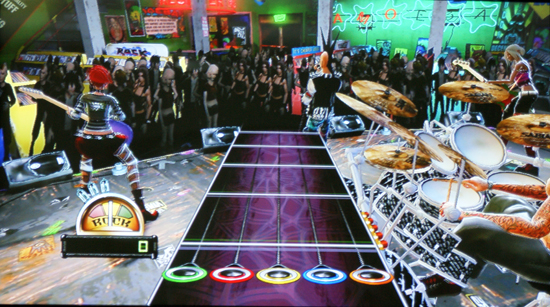
Star power is shared between all band members. Once you collectively acquire enough, anyone can use it. If you build up enough to do so, multiple band members can use star power at once. As with Rock Band, there is an upper limit. Again, the indicators are less than easy to read for all band members as they are the vacuum tubes above the failure indicator. You kind of just have to hope it's there when you need it and that you didn't steal it from someone who needed it more.
The "highway" and the notes are a little different than in Rock Band (more like Guitar Hero 3). The tilt and perspective are slightly different, meaning that as they come down toward you, the spacing of the notes is not exactly the same as on the RB series. The notes also have more "height" to them in GHWT, and this adds to the effect. On RB2, the highway is also slightly convex. Anand feels like you have to have more of an internal sense of timing, but I think it's more about what you are used to.
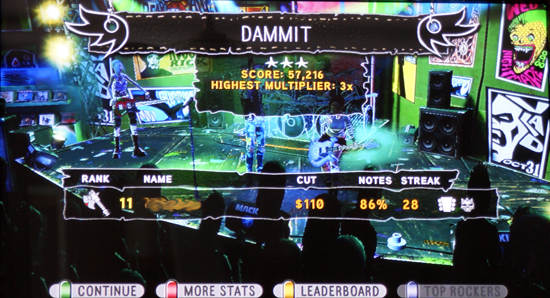
I will say that the flatter, rectangular notes in Rock Band are easier for me to follow visually though. For whatever reason it's easier for me to tell when a rectangle lines up inside a rectangle than when a circle lines up over a circle (or when a line passes through a bunch of circles). Maybe it's just me. You can get a good sense of the differences on youtube, just search for "ghwt rb2" and you'll find lots of side by sides. If you are coming from GH3, you'll be fine, but it might take some getting used to if you've only played Rock Band games.
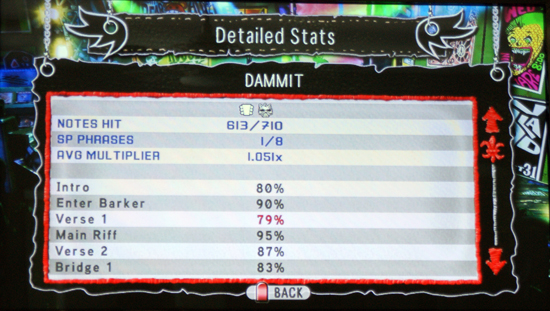
Detailed stats. Awesome. I want this on Rock Band 2.
Another bit I don't like about the highway is that the timing lines are all the same shade in GHWT. In both games, there are lines every eighth note, but in Rock Band, all the "and" lines are lighter. This helps me keep track of timing much better and I don't lose the count as often when it gets super complicated. Again, it's all about what you are used to and what works better for you. Personally I like the RB approach better.
That about does it for the actual playing of the songs. Let's get on to the quickplay and career modes.
Quickplay lets you select up to 6 songs to play back to back from all the music you've unlocked and downloaded. This is where it's at for the party game experience. It's much nicer than picking in between every song, as it allow a smoother gaming flow. We are still working with a flat list, so getting around is just as tough here as it is in Rock Band, but you don't have the help of difficulty ratings (even flawed ones) to help you find what you're looking for.
In quick play, if you can't get past a song you picked, no worries. You can choose to skip that song. This is nice if you run into some unexpected difficulty.
Career mode is much more complex and allows you to unlock songs by going through 5 different "careers." These are the careers of a guitarist, a bassist, a drummer, a vocalist, and a band. I bet you didn't see that coming, huh? For each career type it starts you out with access to a couple different set lists that are geared toward the type of instrument you are using. It starts off with easier stuff and builds up from there.
The problem with this is that in playing through each career you have to start off playing the noob songs each time. If I have to play Beat It or On the Road Again one more time I'm going to lose it. While this is a fine idea, I wish that having unlocked gigs in other careers would carry over, or that I could have one "career" that I could either play solo or with a band when I wanted to. Sort of like Rock Band. The GHWT method just feels clunky and it gets in the way of itself. The cheesy story I could do without as well. I really don't care about battling evil with my music or whatever.
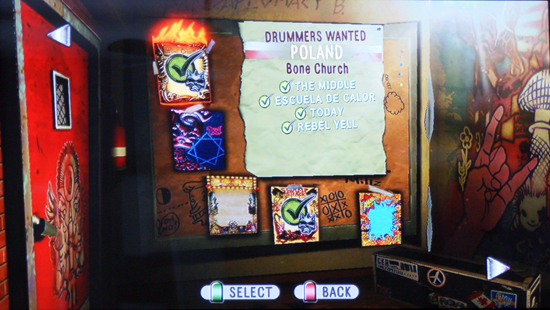
Look, we're in Poland.
With a name like Guitar Hero World Tour, I suppose I expected something a little more epic. With Rock Band 2, navigating gigs was really just going through a bunch of menus, but the game made it sort of feel like you were traveling around the world. You'd fly around when moving between cities, zoom into cities when looking through venues, and dive into the gig when you picked it. Sure, GHWT's gig locations, like Rock Band's, are unique and represent the place you are headed to play, but it just feels lame looking at a wall and picking between some flyers to decide on a gig.
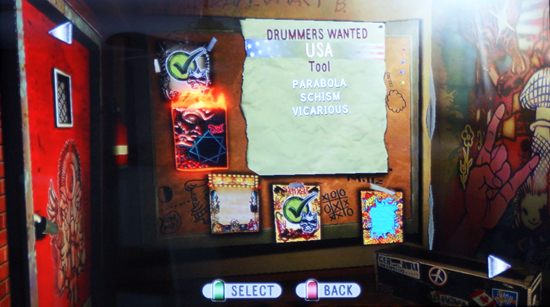
Now we're in the USA. Awesome.
Oh, and you need to pay for some gigs. I think ... well, the last time I checked anyway ... when you play somewhere, the venue pays you. Unless you damage things. That's a whole other story. But seriously, I don't want to buy gigs. Let me unlock them when I've done enough. Or make me buy something else that allows me to play a gig if it's got to be necessary to expend resources to access the songs. But the premise of "buying gigs" is just stupid.
The only other big thing is choosing difficulty levels. You do this at the beginning of your career. The Rock Band model of choosing difficulty at least per gig if not per song is a much better solution. Somethings are too easy to play on less than expert and others are too hard to play on more than medium. I don't want to be stuck into one difficulty the whole time.
Well, you can change the difficulty if you fail a song. But that seems like a cheap cop out and I'd rather just skip that step.
All in all, career mode is not as satisfying and not as "world tour"ish as it could be (or as Rock Band 2). Quickplay is great, as that's what we normally do anyway when playing with friends. And that just leaves online play to cover.
Online Play
We had some complaints about Rock Band 2's online play, and Guitar Hero World Tour fixes some of those issues, but creates others. Here's the long and short of it.
In GHWT, you can't coop on your career path. Getting help unlocking songs from random strangers is a nice perk in RB2. Part of the problem in RB2, though, is that you either have to start a band and chose what everyone does all the time, or you have to join a band and be at the mercy of someone else's song picks. GHWT fixes that.
When playing with other people, every song a random band member is picked to chose the next song to play. This allows everyone to take turns choosing songs to play and is much better from a "just wanna play with people online" sort of model. And honestly, this is what we really wanted to do most of the time with Rock Band and had a hard time with. Joining other people's bands just lead to doing stupid challenges or other nonsense, and when we had other people join us they just dropped out and made us fail losing fans all over the place. With GHWT, there is no similar penalty for being screwed and left during a game, and if someone doesn't like the song you picked, they have incentive to stick around in that they might get to pick the next one.
With the headset jack built into the controllers, using voice chat over live is much more accessible. But we still didn't hear a lot of people using it. It is a little less necessary with this setup than with Rock Band though.
On the down side, you have to pick your difficulty setting from the settings menu before the song is picked, so if you go with expert you'd better be ready no matter what song your online friend chooses. Also you only have 10 seconds to decide to edit your settings between songs. So don't be slow either.
It is also not possible, when in the process of matchmaking, to decide you want to wait for a full band. The matchmaking process goes on and gives you one of two options: wait for it to finish working its magic or cancel. You might end up with two people, or one ... or maybe even three (though we were never matched up with 3 people). It's certainly less ambiguous as to whether you should wait for more people or not: you get what you get. But it would still be nice if you could set an option somewhere to definitely wait until you could be matched with at least 2 others if you wanted.
It's not a bad set up, the head to head play is better than in Rock Band, and the cooperative online play is fun as well. Both Harmonix and Neversoft have some things to work on for their next installment. Neither RB2 nor GHWT is perfect in the online department, but both have their strengths and weaknesses. Honestly, the best and most consistent way to have fun online is to play with friends you already know and skip the matchmaking. That's a good time on either game.
Final Words
So what do we have? Something better, something worse. Something good and something bad. Guitar Hero World Tour is not perfect. But neither is it a waste.
Guitar Hero World Tour is, in our opinion, the best music game out there when it comes to guitar simulation. The added tweaks like open notes, the neck slider (even though it's tough to use and a little gimmicky), and the physical changes to the guitar itself have really gone a long way to keep the original franchise on top in this department. There are some songs with a more interesting guitar implementation on Rock Band 2, but then there are some songs with a better adaptation on Guitar Hero World Tour. All in all, GHWT is best for guitar and bass fun. That's not to say it couldn't be better if it took some cues from Rock Band for the interface. But the actual playing of the notes is just more interesting.
Having said that, for everything else, we prefer Rock Band 2.
The drum kit, while interesting, features the worst kick pedal imaginable (to be fair, we haven't tried Konami's, but we don't expect much there). The cymbal positions don't really feel right for some songs and the cymbals are not nearly as responsive as the awesome pads (which are better than everything but the ION pad). The pad layout is awkward at times, and the mapping of the songs to the kit can be frustrating whether on a GHWT kit or on an RB kit. The only reason to pick up the GHWT drum kit is if you have an electronic kit with a midi out and you would rather play that. But even then, if you're a drummer, you might want to wait and see how well that works (if it works) with Rock Band 2, as Harmonix built the better overall drumming experience. And activating star power with the drums is just unreasonable in some songs in GHWT.
Drumming in GHWT could be better with a properly laid out electronic kit or an ION Drum Rocker with the blue cymbal added on. I think I've got the best layout for it, but it's still more complicated than it needs to be and not as intuitive as RB2. For those that care, what you want, from left to right is: yellow cymbal, red pad, yellow pad, blue pad, green cymbal, green pad, blue cymbal. Obviously the cymbals would be raised, but you would also want to get the red and blue pads as close as possible and maybe raise the yellow pad up out of the way a bit.
Vocals in GHWT can be frustrating, as it's really hard in some songs to hit the transitions properly. It also seems pickier about matching pitch than Rock Band 2. Activating star power essentially requires interaction with the XBox controller as tapping the mic really doesn't work well.
The interface in GHWT is clunky and career mode is tedious. We prefer the non-cartoonish look of Rock Band, but that's just a preference issue really. But while we're at it, the character animation in Rock Band 2 is MUCH more acurate. the fingering and picking of guitars and bass and the drumming are very evenly matched and smooth in Rock Band 2 even on complex songs. In Guitar Hero, some things are just wrong and many motions are abrupt and jerky.
Picking difficulty for an entire career is also unsatisfactory. This should be on at least a gig level.
Honestly, I wish we could take the songs from GHWT along with the guitar innovations and some online play tweaks and shove them into Rock Band 2. That would give us nearly the perfect music game experience. Oh, but we need a better kick pedal. For both GHWT and RB2. And a hi-hat pedal. And more drum triggers (but done the right way)... On second thought, we've got a long way to go until we see the perfect music game.
But for now, GHWT is great for guitar and bass, but Rock Band 2 takes the cake for drums and overall gaming experience.







